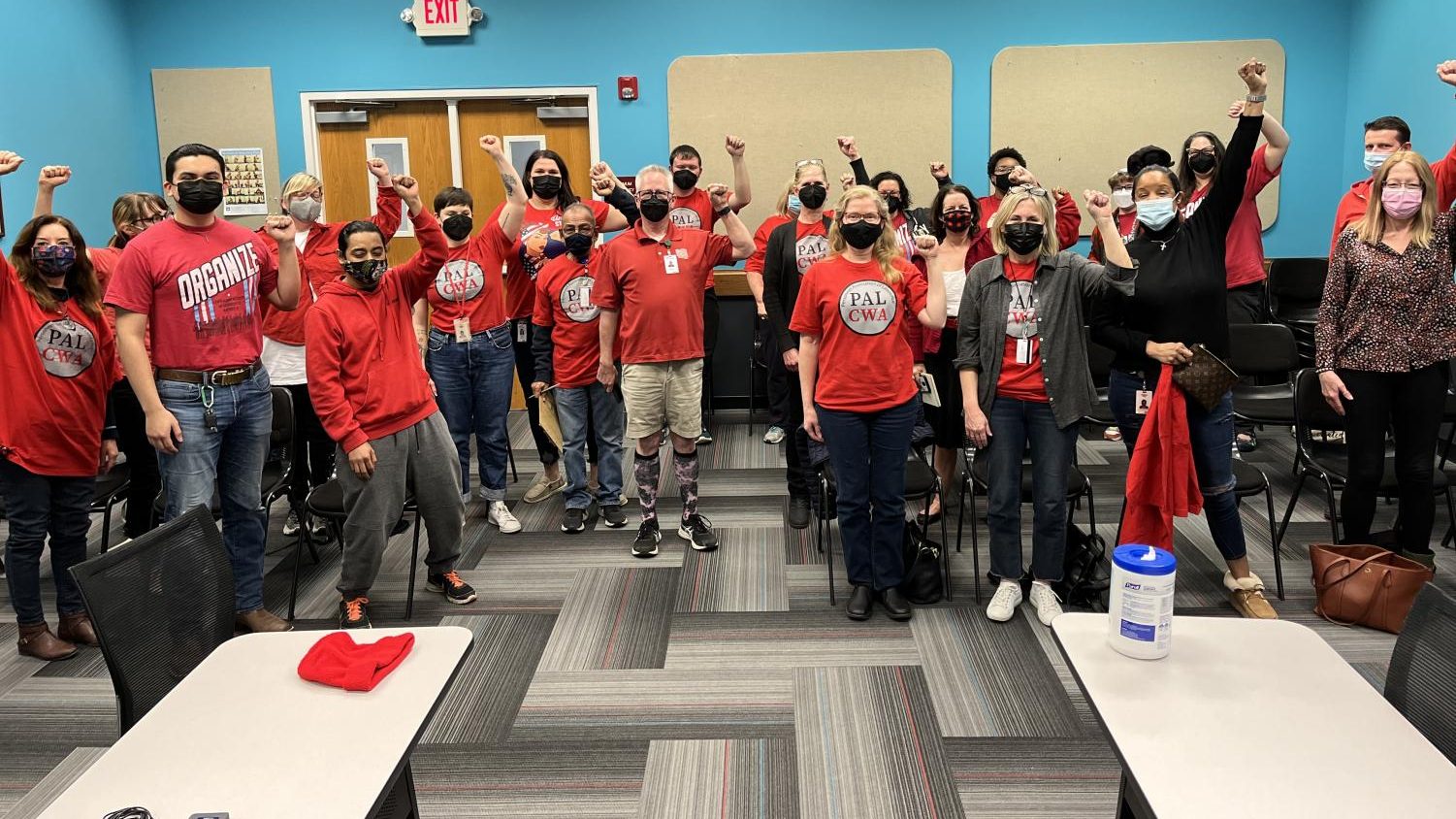USD 497’s classified staff hope to be David against Goliath
How a national labor movement is inspiring Lawrence’s classified staff to fight for their working conditions, even amid a retention crisis.
April 27, 2022
As paraeducator Paul Brecht steps out of his classroom for an interview, he knows it will put a strain on some of his colleagues.
It’s his lunchtime, but he has no lunch break to talk to us. On a normal day, he still has to work while he eats lunch. His colleagues help cover the responsibilities so they can all find time to eat while still watching their students.
But today Brecht is leaving his lunchtime to tell us about his job and his union. After the short 20-minute interview he will quickly grab a tray of food from the cafeteria and return to work. His brief respite to speak to us will be the longest break he has all day. On normal days, he doesn’t get a break at all.
Brecht is in his fifth year as a paraeducator at Lawrence High School. His job has him work hands-on with students in the school. Brecht’s role is challenging. Due to the wide array of student needs he is tasked with meeting, he said it’s nearly impossible to be fully trained to deal with all of them, especially with the limited training paras receive.
Brecht works long days in an ever-shifting role with no breaks. He makes less than $13 per hour, less than many LHS students make at their part-time jobs working in the fast food industry or retail.
There’s a game paras play where they discuss how they are able to work as paraeducators, Brecht told us. Do they rely on a spouse? Are they working multiple jobs? Living with four roommates? Commuting from an hour away?
“Everyone has something that they have to do in order to make ends meet,” Brecht said. “No one can just work an honest day’s work and have that be enough.”

Brecht is a member of a group of district workers known as classified staff members. Alongside paraeducators, these roles include food service workers, library media workers, secretaries, custodians and other non-certified positions. Brecht’s working conditions and pay are reflective of classified staff as a whole where hundreds of district employees make between $11/hr and $13/hr.
Brecht is also a part of the Personnel Association of Lawrence or PAL-CWA. PAL-CWA is the union that fights for the working rights of classified staff members. Where certified teachers have the Lawrence Education Association (LEA), classified staff have the PAL-CWA.
Recently PAL-CWA has been in negotiations with the district over a wide array of proposals regarding working conditions and recent negotiations have prompted increased concerns from classified workers. Due to the multi-million dollar budget deficit facing Lawrence Public Schools, the future of their jobs, and the future of education as a whole in Lawrence Public Schools has come into question.
It also hits at a time when inflation is impacting the bottom line of district employees and entry-level pay at fast food restaurants tops what they’re earning.
Any solution is murky given the budget cuts but one thing has remained clear: The union is ready to fight.
History of PAL-CWA’s negotiations with the district
This year is PAL-CWA’s first year on a contract with Lawrence Public Schools. The contract was for only one year, meaning that negotiations have already begun for next year’s contract between the union and the district.
PAL-CWA made their first round of proposals in March. The group’s requests included raises and the implementation of 15-minute breaks, which they argued aligned with a changing labor environment.
These proposals, they’re pretty heartless.
— Hannah Allison-Natale, PAL-CWA president
In the second session of negotiations held in early April, the union heard back from the district. What was left was a hollow shell of what used to be. Gone were raises to a living wage and two 15-minute breaks were no more. Paid snow days were written out of the contract and new restrictions on paid time off were written in.
“These proposals, they’re pretty heartless,” PAL-CWA president Hannah Allison-Natale said. “To not give people snow days they already had this year, to not give people 15-minute breaks and say, ‘No you don’t need to pee, and it’s unfeasible for you to have time to go to the bathroom.’ It feels like it came from an attorney and not from some of the other people at the table.”
The district is being represented in negotiations by David Cunningham, an attorney with the Kansas Association of School Boards who retired from USD 497 last year.
“The school board and administration value all staff and the role each staff member plays in supporting student achievement and success,” USD 497 Executive Director of Communications Julie Boyle said. “It is the goal of both the board and the administration to improve the salaries of employees at all levels, including classified staff represented by PAL-CWA. The board and district have been working toward that end for several years.”
For the union, one of the main sticking points is the district’s attempt to take away any wording offering staff two 15-minute breaks throughout the day. The district’s view is that there is no way to implement the breaks.
The other main focus for the union is wages. Currently, most classified staff make less than a living wage for Douglas County. The union proposed a 40% raise for all classified staff. This number, union leaders advocate, would allow every classified staff member to make at least a living wage.
Last year, the union fought hard for an increase in wages and only received a .24% increase, which amounted to a few cents. Both sides of negotiations agreed this was insufficient and made commitments to be more proactive in the next round of negotiations. But as these rounds of negotiations have begun, the union has still yet to see a wage offer.
Although the district acknowledges the lack of raises, officials highlighted that raises have been given to staff in the past. For the 2020-2021 school year the district allocated raises of 3.3% for classified staff, 2.4% for teachers and 2.38% for administrators.
The district has also sought out other ways to help classified staff members. Boyle explained ways the district seeks to value classified staff, including paid snow days, financial awards and full benefits.
Allison-Natale recognized these benefits but challenged the efficacy of them. Although benefits and insurance packages are helpful, getting staff members to a living wage line was still a top priority, they said.

Regarding paid snow days, Allison-Natale noted that the district specifically removed wording guaranteeing paid snow days from the union’s proposals, leaving the door open for the district to choose not to pay classified staff on those days, forcing them to use vacation time or forgo pay.
Another change made by the district was additional restrictions on when classified staff could use their paid time off. Certified teachers represented by the LEA have no restrictions on their paid time off, a difference noticed by Allison-Natale.
“This is just more evidence that we are effectively a class of workers that the district respects less,” they said. “Which is so unfortunate because we love our students and what we hear all the time from our members is that people love their jobs.”
But the union’s push to do more for the district’s lowest-paid workers comes at a time when the district is battling budget shortfalls.
“The school board must balance its priorities, including raising employee salaries, ensuring safe learning environments and improving student learning and success, with available financial resources,” Boyle said.
The school board approved $6.4 million in budget reductions on March 28 after months of debate. This figure is higher than the amount needed to bridge the district’s shortfall in order to raise staff salaries. A 1% increase to entire employee salary pools costs the district $825,000.
“The economic reality is that we do not have a healthy budget to sustain district operations across the board without making substantial cuts,” board president Erica Hill said, “which is why the board had to make tough budget decisions, recently.”
Also frustrating union leaders is a move to remove employment protections for classified workers. Last year, according to Allison-Natale, the union was able to negotiate “just cause” into its contract, meaning employees couldn’t be fired without the district demonstrating a reason. USD 497 has sought to remove that protection.
This is just more evidence that we are effectively a class of workers that the district respects less.
— Hannah Allison-Natale, PAL-CWA president
The two sides reached one compromise in the slew of proposals. The union’s proposed changes to the grievance process for workers was, although altered slightly by the district, eventually agreed upon. This change allows for more ease and clarity for workers to claim grievances against their supervisors if they’re put in a bad situation, such as being in an unsafe work environment.
The next set of negotiations will be held in May.
The classified staff crisis
The consequences of inaction are dire, union leaders said.
“We’re already in that crisis right now,” Allison-Natale said.
Allison-Natale said that about 10 classified staff members in the district leave their roles every month. From the time Allison-Natale started as union president three years ago, the district is down about 200 classified staff.
Boyle recognized this lack of workers and its adverse effects on student learning, but noted that it was indicative of nation-wide trends.
“The district has operated with unfilled paraeducator, food service and custodial positions for the past two years, in addition to some hard-to-fill certified positions,” Boyle said. “These challenges do affect the quality of education and support services the district is able to provide all students.”
I’m the only one who’s left.
— Paul Brecht, LHS paraeducator
The district ensured it is working to fill open positions and retain classified staff. One method for doing this was to offer all eligible employees a Retention Incentive Payment Plan using American Rescue Plan Act Elementary and Secondary School Emergency Relief (ESSER) Funds. They also hired former Quail Run teacher Kaitlin Shulman as coordinator of recruitment and retention, and heavily expanded its recruitment and advertising for job openings.
The school board recognized retention concerns but maintained a commitment to ensuring a plan is in place to keep high-quality staff in Lawrence.
“People leave jobs for many reasons; however, inadequate salary, feeling overworked and/or unsupported, and a lack of recognition are the common concerns that have been expressed,” Hill said, “so there will need to be a plan implemented to address these concerns.
But as both Brecht and Allison-Natale note, classified staff shortages remain a crisis for the district.
“Retention is already abysmal,” said Brecht “and we’ve been seeing a mass exodus out of the district.”
From when Brecht started with LHS five years ago, every other member of the original team of educational paraprofessionals has left. Brecht is the only one who stayed. One of the paras who left even stayed in the building and took a pay cut just to move out of a para role into a lower stress role and get out of the situation they were in.
“I’m the only one who’s left,” he said. “And I’m not the best person from that time-period. I watched so many people who had a gift and a love for working with the kids who just couldn’t hack it anymore. Who were so tired of being disrespected and underpaid and eventually just had to make choices for their own financial stability and their own mental health to be elsewhere.”
Our working conditions are student learning conditions.
— Hannah Allison-Natale, PAL-CWA president
Even the staff that stay continue to struggle. And that struggle inevitably impacts their ability to best serve their students at school.
“Our working conditions are student learning conditions,” Allison-Natale said. “So when you have a paraeducator who is exhausted because she’s working two other jobs and she’s trying to feed her own kids and she can’t afford to do that, the quality of that person’s work is just lower.”
According to teachers who work with paras, classified staff alleviate the burden of certified teachers while providing students with a wide array of services throughout the school day. Some of these classified staff work with all students, such as library media workers and custodians. Others, like Brecht, work with specific students that have additional needs. Whereas a teacher oversees instruction for 30 students, a para can offer a student very specific support that isn’t instructional and that a teacher may not be able to provide.
“We have students who need one-on-one attention and guidance throughout the entire day,” Lawrence High IPS teacher Susan Mička said. “The para-educators provide social, educational and personal care support to these students. Paras are often the link to inclusion for many. Without one-on-one support, these students would be maintained in a solitary classroom, not able to access their peer group or an inclusive and equitable education.”
Classified staff members are here to stay – and fight
So what happens now? How do these negotiations end? And, most importantly, what does this mean for the students of USD 497 schools?
Both Brecht and Allison-Natale acknowledged that the solution isn’t necessarily easy. But they enforced one idea that is drawn from recent national labor movements: the union, and its members, are here to stay and fight for education in Lawrence.
“We’re not quitting jobs anymore,” Allison-Natale said. “We’re staying to fight. They win when we quit.”
For Allison-Natale, PAL-CWA and unions like it aren’t just about labor rights. They’re also about forming a community between workers. They brought up times when members of the union had helped out others with purchasing dog food and filling other needs.
“My hope is that we don’t reach that point because we have such an amazing union full of really amazing, wonderful staff who are dedicated to students, who are dedicated to these jobs,” Allison-Natale said. “We’re going to keep fighting and trying to make this fight as public as possible.”
Allison-Natale said that at the end of the day, the tipping point in negotiations is wages. Classified staff simply cannot work at the highest level and with the highest retention with the wages they are currently offered.
We’re not quitting jobs anymore.
— Hannah Allison-Natale, PAL-CWA president
But regardless of how negotiations end up, classified workers in the district see themselves as a part of a broader labor movement. A movement with groups of workers from across the county from Starbucks to Amazon. When Staten Island Amazon workers unionized in early April, many saw it as a David beating Goliath story, one that has inspired other Davids around the country to seek labor rights and unionize.
PAL-CWA hopes to be the next David.
“People want to stay in this district, they love working in our district, there’s so much about our jobs that’s incredibly rewarding,” Allison-Natale said. “It is really meaningful to get to be a part of someone’s education or a part of someone’s life while they’re in school. Our members know how unfair it is and how it’s just not right.
“I think people want to fight.”
